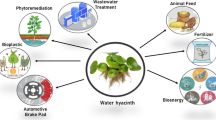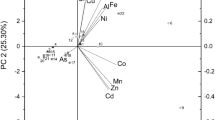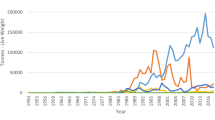Abstract
Ecklonia cava and Ecklonia stolonifera are perennial brown algae that form sea forests off the coast of Korea. Both species are cultured to supply a summer feed for the abalone industry. Recent expansion of the abalone industry in Korea has been bringing an increase in demand for fresh algal supply. Zoospores of the two algae were seeded in October 2006 on seed frames coiled with 100 m of seed fibers. After 2 months of indoor culture and 2 months of intermediate culture, growth and production of the two algae were compared during their main cultivation period from March 2007 to June 2008, in the culture ground in Wando, Korea (34°26′18.68″ N, 127°05′43.88″ E), in situ. Growth rate of E. cava and E. stolonifera was 1.058 and 3.089 mm day−1, respectively. The mean production of E. stolonifera obtained from the culture ropes was ca. 12 kg wet wt. m−1 of culture rope while production of E. cava was ca. 3 kg wet wt. m−1 of culture rope. The difference in production was attributed from the different growth strategies of the two algae, with only E. stolonifera being able to regenerate blades from the holdfast. The ability to regenerate blades from the holdfast therefore makes E. stolonifera the preferred species for biomass production for abalone feeds. In a 120-day feeding experiment, growth rate, weight gain, and survival rate of abalone showed that E. cava and E. stolonifera feeds could provide an alternative feed to Saccharina japonica during summer months.




Similar content being viewed by others
References
Corazani D, Illanes JE (1998) Growth of juvenile abalone, Haliotis discus hannai Ino 1953 and Haliotis rufescens Swainson 1822, fed with different diets. J Shellfish Res 17:663–666
Edding ME, Tala FB (2003) Development of techniques for the cultivation of Lessonia trabeculata Villouta et Santelices (Phaeophyceae: Laminariales) in Chile. Aquacult Res 34:507–515
Hwang EK, Baek JM, Park CS (2009) The mass cultivation of Ecklonia stolonifera Okamura as a summer feed for the abalone industry in Korea. J Appl Phycol 21:585–590
Hwang EK, Gong YG, Ha DS, Park CS (2010) Nursery and main culture conditions for mass cultivation of the brown alga, Ecklonia cava Kjellman. Korean J Fish Aquat Sci 43:687–692
Kang JW (1966) On the geographical distribution of marine algae in Korea. Bull Pusan Fish Coll 7:1–125
Macey B, Coyne V (2005) Improved growth rate disease resistance in farmed Haliotis midae through probiotic treatment. Aquaculture 245:249–261
MIFAFF (2010) Fisheries resources management (Low No. 10599). Korea Ministry of Government Legislation. http://law.go.kr/lsSc.do. Accessed 10 May 2012
Ohno M (1985) Marine forest—its ecology and constructing technology. (In Japanese). Kaiyo Kagaku 17:706–713
Park CS, Hwang EK, Lee SJ, Roh KW, Sohn CH (1994) Age and growth of Ecklonia stolonifera Okamura in Pusan bay, Korea. Bull Korean Fish Soc 27:390–396
Serisawa Y, Yokohama Y, Aruga Y, Tanaka J (2002) Growth of Ecklonia cava Kjellman (Laminariales, Phaeophyta) transplanted to a locality with different temperature condition. Phycol Res 50:201–207
Serviere-Zaragoza E, Gomez-Lopez D, Ponce-Diaz G (1998) The natural diet of the green abalone (Haliotis fulgens Philippi) in the southern part of its range, Baja California Sur, Mexico, assessed by an analysis of gut contents. J Shellfish Res 17:777–782
Silva-Aciares FR, Carvajal PO, Mejías CA, Riquelme CE (2011) Use of macroalgae supplemented with probiotics in the Haliotis rufescens (Swainson, 1822) culture in Northern Chile. Aquacult Res 42:953–961
Troell M, Robertson-Andersson D, Anderson RJ, Bolton JJ, Maneveldt G, Halling C, Probyn T (2006) Abalone farming in South Africa: an overview with perspectives on kelp resources, abalone feed, potential for on-farm seaweed production and socio-economic importance. Aquaculture 257:266–281
Yokohama Y, Tanaka J, Chihara M (1987) Productivity of the Ecklonia cava community in a bay of Ize Peninsula on the Pacific coast of Japan. Bot Mag Tokyo 100:129–141
Acknowledgments
This work is funded by NFRDI (RP-2013-AQ-002) and Priority Research Centers Program through the National Research Foundation of Korea which is funded by the Ministry of Education, Science and Technology (2009-0093828). The authors would like to thank Dr. Philip Heath (NIWA, New Zealand) for reviewing the English of the paper.
Author information
Authors and Affiliations
Corresponding author
Rights and permissions
About this article
Cite this article
Hwang, E.K., Gong, Y.G., Hwang, IK. et al. Cultivation of the two perennial brown algae Ecklonia cava and E. stolonifera for abalone feeds in Korea. J Appl Phycol 25, 825–829 (2013). https://doi.org/10.1007/s10811-012-9941-y
Received:
Revised:
Accepted:
Published:
Issue Date:
DOI: https://doi.org/10.1007/s10811-012-9941-y




